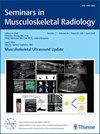股骨近端骨内许旺瘤
IF 1.1
4区 医学
Q4 RADIOLOGY, NUCLEAR MEDICINE & MEDICAL IMAGING
Seminars in Musculoskeletal Radiology
Pub Date : 2024-12-01
Epub Date: 2024-11-19
DOI:10.1055/s-0044-1791203
引用次数: 0
摘要
骨内裂隙瘤是一种罕见的良性神经鞘瘤,由以下部分组成本文章由计算机程序翻译,如有差异,请以英文原文为准。
Proximal Femoral Intraosseous Schwannoma.
Intraosseous schwannoma is a rare benign nerve sheath tumor comprising < 1% of bone tumors. Relatively common locations for this tumor include the skull and mandible, and, to a lesser degree, the spine and sacrum. Intraosseous schwannoma involving the appendicular skeleton is exceedingly rare. The clinical and imaging presentation, as in this case, is nonspecific and includes pain in the setting of a lytic bone lesion. The first step in management is bone biopsy that often produces greater than expected pain. Definitive management is surgical.
求助全文
通过发布文献求助,成功后即可免费获取论文全文。
去求助
来源期刊
CiteScore
2.50
自引率
7.10%
发文量
112
审稿时长
>12 weeks
期刊介绍:
Seminars in Musculoskeletal Radiology is a review journal that is devoted to musculoskeletal and associated imaging techniques. The journal''s topical issues encompass a broad spectrum of radiological imaging including body MRI imaging, cross sectional radiology, ultrasound and biomechanics. The journal also covers advanced imaging techniques of metabolic bone disease and other areas like the foot and ankle, wrist, spine and other extremities.
The journal''s content is suitable for both the practicing radiologist as well as residents in training.

 求助内容:
求助内容: 应助结果提醒方式:
应助结果提醒方式:


